It's peak season for my two favourite inconvenience foods – persimmons and quinces. 'Inconvenience' foods? Yep. These babies aren't quick and easy to eat. You have to earn them, you have to wait and, best of all, they're available for just a few months every year. After the season is over, you have to be patient... and wait ... until next year. I like that!
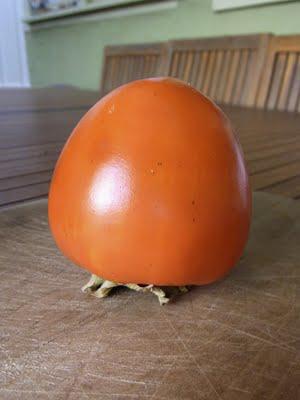 This dome-shaped person is an astringent persimmon. Should you foolishly attempt to eat this thing while firm and unripe, I have been told your mouth will pucker instantly with the bitterness, and stay puckered for ages. And you'll never do that again, either. Fortunately for me I was forewarned and I did what everyone should do: I waited until it softened, and softened some more, then finally arrived at the "I'm about to disintegrate with softness" stage. Then it's ready to eat. It's my favourite breakfast during its season of autumn and early winter. I like to think of it in an anti-marketing way as "Cereal with Disintegrated Inconvenience Food Collapsed over the Top". Catchy name? Yummy, I say.
This dome-shaped person is an astringent persimmon. Should you foolishly attempt to eat this thing while firm and unripe, I have been told your mouth will pucker instantly with the bitterness, and stay puckered for ages. And you'll never do that again, either. Fortunately for me I was forewarned and I did what everyone should do: I waited until it softened, and softened some more, then finally arrived at the "I'm about to disintegrate with softness" stage. Then it's ready to eat. It's my favourite breakfast during its season of autumn and early winter. I like to think of it in an anti-marketing way as "Cereal with Disintegrated Inconvenience Food Collapsed over the Top". Catchy name? Yummy, I say.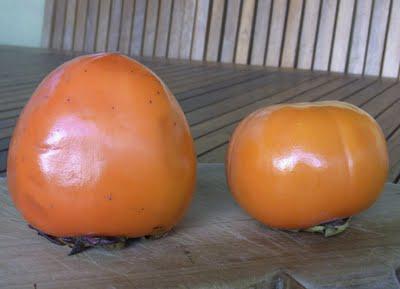 On the left is the astringent persimmon, the one with the dome, and on the right is the modern convenience food type of persimmon, the non-astringent type, the flatter one, also known as Fuji, Kaki and various other names. The non-astringent types are much more sensible things. You can eat them crisp like an apple or let them ripen until softer and eat them, say, like a ripe pear. They're nice, and they are of course much more popular than the highly inconvenient astringent persimmon. But I like the weirdo on the left more because, in the end, it wins the big prize: it tastes better.
On the left is the astringent persimmon, the one with the dome, and on the right is the modern convenience food type of persimmon, the non-astringent type, the flatter one, also known as Fuji, Kaki and various other names. The non-astringent types are much more sensible things. You can eat them crisp like an apple or let them ripen until softer and eat them, say, like a ripe pear. They're nice, and they are of course much more popular than the highly inconvenient astringent persimmon. But I like the weirdo on the left more because, in the end, it wins the big prize: it tastes better.As this is a gardening blog most of the time, I should pause for a moment to say that no, I am not about to tell you how I grow persimmons here, because I don't. I could struggle along against the laws of nature and keep a persimmon tree alive here, sure, but it wouldn't be a happy person. Persimmons like a mildly chilly winter as a part of their fruit-making cycle, and Sydney can't supply that, especially where I am in the mild zone near the coast. My area is, alas, too warm for raising successful crops of my other favourite fruits such as apples, nashi pears and quinces, so I don't bother growing them, either. And so I content myself with letting other people in the right climates grow quality crops of the fruits I love, and I'm happy just to buy some, to keep them in business doing what they do so well.
Did I just mention quinces? My other favourite inconvenience food. They're in season now, and I love them as much as I love persimmons.
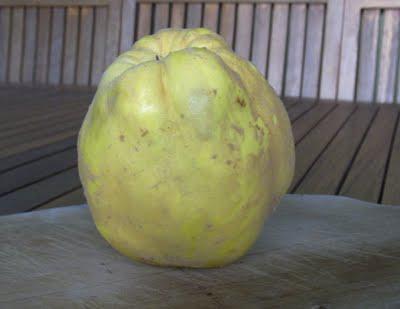 Bought this one yesterday, and it's wonderfully inconvenient too. And seasonal as well. When fruits are available for just a few months each year they remain special. As soon as the modern world decrees that the spoilt child known as the average consumer simply insists on having their favourite fruit for 365 days a year, then the poor fruit loses some of its charisma. Absence does make the heart fonder for fruit. Such a thrill to see the first quince of the season each year, and to know what lies ahead for the next few months.
Bought this one yesterday, and it's wonderfully inconvenient too. And seasonal as well. When fruits are available for just a few months each year they remain special. As soon as the modern world decrees that the spoilt child known as the average consumer simply insists on having their favourite fruit for 365 days a year, then the poor fruit loses some of its charisma. Absence does make the heart fonder for fruit. Such a thrill to see the first quince of the season each year, and to know what lies ahead for the next few months. 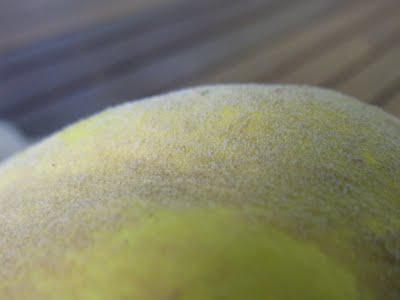 I love this part of quinces, the soft downy bloom which appears on the skin. It's harmless and rubs off or washes off (or disappears in the peelings anyway) but I have seen people in shops almost recoil in horror when they discover that there is "something" on that fruit! So many modern fruit shops, with their gleaming over-polished apples and art-directed displays of coordinated colours, are almost sanitised in their drive for visual perfection. And then over to the side, away from the main show, there are the quince trays, fluffy with down and looking like a bunch of unshaven hobos needing a wash. Often I think they're the only truly natural looking thing left in some modern fruit shops.
I love this part of quinces, the soft downy bloom which appears on the skin. It's harmless and rubs off or washes off (or disappears in the peelings anyway) but I have seen people in shops almost recoil in horror when they discover that there is "something" on that fruit! So many modern fruit shops, with their gleaming over-polished apples and art-directed displays of coordinated colours, are almost sanitised in their drive for visual perfection. And then over to the side, away from the main show, there are the quince trays, fluffy with down and looking like a bunch of unshaven hobos needing a wash. Often I think they're the only truly natural looking thing left in some modern fruit shops.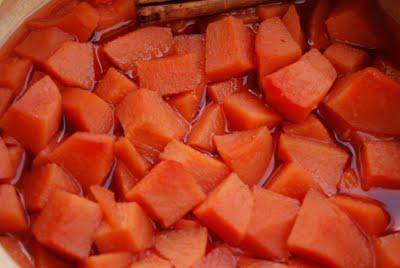 As soon as I finish writing this blog this little quince is going to be peeled, cut into chunks, sprinkled with sugar, sloshed with water and tossed into a covered small baking dish, along with a cinnamon stick, to slowly turn bright, bright red and become yet another cool season breakfast treat. It takes three or four hours for the flesh to change from the original off-white to this wonderful colour, and while that happens the house fills with the aroma of the quinces meeting the spice of the cinnamon. It might take a while, but the inconvenience is always worth it.
As soon as I finish writing this blog this little quince is going to be peeled, cut into chunks, sprinkled with sugar, sloshed with water and tossed into a covered small baking dish, along with a cinnamon stick, to slowly turn bright, bright red and become yet another cool season breakfast treat. It takes three or four hours for the flesh to change from the original off-white to this wonderful colour, and while that happens the house fills with the aroma of the quinces meeting the spice of the cinnamon. It might take a while, but the inconvenience is always worth it.